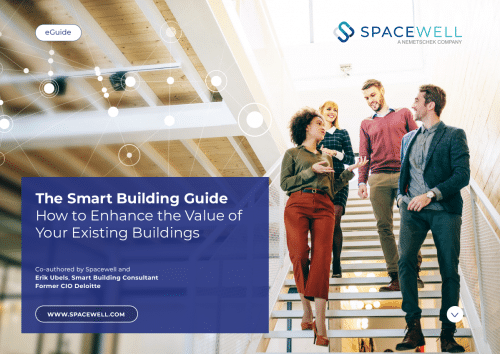Even as we focus our efforts on confronting the challenges of COVID-19, Spacewell continues to plan for the future. Our guiding principle has been to structure our vision around the demands and needs of our core constituents: building managers, users, and service providers. We believe that technologies that succeed in the long term are those that offer genuine benefits, driving further developments and progress. When it comes to the built environment, the result will be a world in which buildings become more autonomous and at the same time more centered on the user experience.
Corporate Buildings: The Macro Picture
At the highest level, demand for commercial buildings has long been moving away from a utilitarian vision of a place to do business. Office designs are enhancing the social and creative aspects of the workplace while still fulfilling the need to concentrate and focus. To varying degrees, buildings have also been embracing sustainability goals, from energy efficiency to minimizing carbon footprints, and the real financial gains from these improvements will continue to drive these trends in the future.
Beyond this macro trend, however, the pandemic has unlocked a broader definition of the workplace, at least among white-collar/knowledge workers. Rather than simply being defined as the corporate office, the workplace will be where the workers are – whether that is sitting in HQ, visiting a client site, or logging in from home or the local coffee shop. The rapid advancements in remote work technology are opening up new possibilities for productive and fulfilling work, introducing flexibility around styles and places of work.
Stakeholder Needs
These macro trends create new challenges for building managers, who need to identify new ways of capturing information and directing services. One solution is to embrace entire systems of smart buildings or even smart cities to service people as they move across different “office” environments. Connectivity will create new marketplaces that cater to user needs, with better-connected, user-friendly spaces drawing more tenants and workers. This shift will require standardization of data processing and exchange and new ways of approaching information sharing across different spaces within the office ecosystem.
With exponential increases in the amount of information that needs to be processed, much of this system will come to be managed by autonomous building systems that are able to process and act upon information without human intervention (though always with human supervision). This will be even more true as data is aggregated across a wide range of sources and centralized in a single digital twin that reflects the complexity of the real world and offers the potential for a more tailored building experience.
Personalized Services
Such a world will empower users in new ways as they choose where to work. In order to market themselves to end-users and tenants (and thereby generate value for investors and owners), buildings will increasingly enable the personalization of services, from room reservation suggestions to lighting dimmers to temperature control. Built around “personas” or linked to personal assistants tied to users’ mobile technology, buildings can offer an inviting, productive space for different types of user needs.
Remote Monitoring and Operations
Facility management companies and service providers, on the other hand, will be able to leverage the advances in building systems, IoT, and mobile apps to manage more and more functions from remote operation centers. This remote shift will go hand-in-hand with better service delivery for end-users as sensors and user feedback result in more responsive service delivery. Property owners likewise benefit as easier coordination and centralization of information can raise rent or lease durations while increasing building value.
Autonomous Buildings Enhancing Value for End-Users
The final exciting development goes beyond the current stakeholders to anticipate the future needs of building occupants. Drawing on diverse data streams from within this ecosystem, it will be possible to design new buildings to address bottlenecks, needs, or preferences that are revealed as potential issues in current designs. Coupled with simulations enabled by extensive digital twin data, designers can evaluate the downstream effects of their choices, and building managers in the operational phases can more easily test different scenarios while lowering cost and disruption. Building life-cycle intelligence will therefore drive a virtuous cycle of increasingly responsive and user-centric building design. While many of us still cannot go back to our offices, the smart autonomous buildings of the future will be places we will all want to go.








